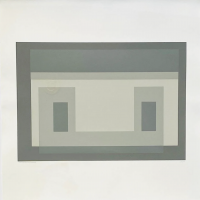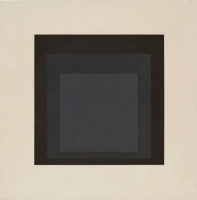
Details
Artist
Styles
Lithograph in colors -Signed, Dated and Titled // Josef Albers’ WLS IV White Line Squares (Series I) is a limited edition lithograph from 1966 that exemplifies his exploration of color interaction and perception. This work features nested squares in earthy tones of brown and olive, each layer subtly shifting in hue, with a thin, delicate white line framing the inner forms. Albers' minimalist composition and precise color gradation invite viewers to observe how adjacent colors influence perception, creating a meditative experience. This piece is part of Albers’ renowned White Line Squares series, which reflects his foundational work in color theory and geometric abstraction.
WLS IV White Line Squares (Series I), 1966
form
Medium
Size
62.2 x 62.2 cm
- Inches
- Centimeters
Edition
Price
Details
Artist
Styles
Lithograph in colors -Signed, Dated and Titled // Josef Albers’ WLS IV White Line Squares (Series I) is a limited edition lithograph from 1966 that exemplifies his exploration of color interaction and perception. This work features nested squares in earthy tones of brown and olive, each layer subtly shifting in hue, with a thin, delicate white line framing the inner forms. Albers' minimalist composition and precise color gradation invite viewers to observe how adjacent colors influence perception, creating a meditative experience. This piece is part of Albers’ renowned White Line Squares series, which reflects his foundational work in color theory and geometric abstraction.
- Recently Added
- Price (low-high )
- Price (high-low )
- Year (low-high )
- Year (high-low )
Josef Albers
Variants-III (from The Ten Variants Series), 1966
Limited Edition Print
Screen-print
Inquire For Price
Josef Albers
Late, From Soft Edge-Hard Edge, 1965
Limited Edition Print
Screen-print
USD 10,000 - 15,000
Josef Albers
I-S VA 4 (from Six Variants Suite), 1969
Limited Edition Print
Screen-print
USD 5,000 - 7,000
Josef Albers
GB 2 (From Homage To The Square), 1969
Limited Edition Print
Screen-print
Currently Not Available
Josef Albers
Concord (From Dei Oberflache), 1965
Limited Edition Print
Screen-print
Currently Not Available
What is minimalism?
Minimalism is a style in music and visual arts characterized by pared-down designs and simplicity. It began in Western art after World War II, gaining prominence particularly in American visual arts. Minimalism draws heavily on aspects of modernism and is often viewed as a reaction against Abstract Expressionism, as well as a precursor to post-minimal art practices. Prominent minimalist artists include Agnes Martin, Donald Judd, Robert Morris, Frank Stella, and Dan Flavin.




















